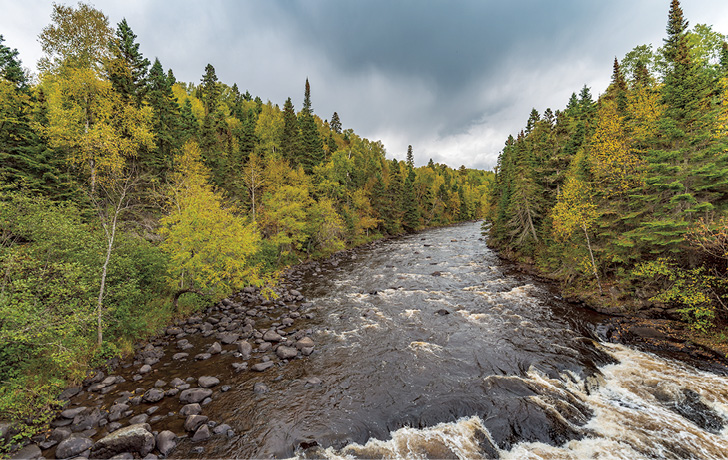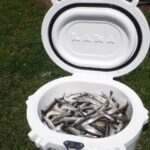As we all experienced, the last few years saw a significant increase in outdoor recreation as Minnesotans headed out in droves to get away from urban areas. The North Shore seemed to take the brunt of the exodus, or so it seemed. State parks and wayside rests were packed with canoers, campers, bikers, anglers, and hikers. Campgrounds were filled and the overflow set up their tents or trailers on logging roads, beaches, and even in private driveways. Parking lots were congested and traffic was bothersome. At the same time, no trespassing signs sprouted as residents reacted to the invasion. As an avid angler, I discovered new restrictions along the Brule River, the Sucker River, and Palisade Creek, where a no trespassing sign was stuck into the ditch on the Highway 61 right-of-way. Hopefully, some of this is only temporary.
Adjusting to the new restrictions made me really appreciate the state park and wayside rest system by which we, the public, have access to the rivers and waterfalls of the North Shore, including the Baptism, Split Rock, Cascade, Brule, Onion, Cross, Kadunce, Temperance, and Gooseberry rivers. Consider the effort that our forebearers went through to secure these scenic landscapes as public property, open to all. How limited would our outdoor recreation opportunities be if all these rivers were essentially private like the Manitou?

One to whom we owe a great deal of debt is Clarence R. Magney, the person responsible for many of these acquisitions and the namesake of the state park on the Brule River. Magney was originally from Pierce County in southwestern Wisconsin, in the Driftless area. After receiving an undergraduate degree from Gustavus Adolphus College in St. Peter, Minn., and then a law degree from Harvard, he moved to Duluth and fell in love with the North Shore. There he practiced law, entered politics, and was eventually elected mayor of Duluth in 1917, where he championed the expansion of the city’s park system. In 1943, he was appointed an associate justice on the Minnesota Supreme Court. While leading a very busy career, he was involved in many community activities and served on many boards. Most importantly to us, he was devoted to protecting waterfalls and scenic watersheds along the North Shore. Magney took the initiative to identify important parcels, lay out the rationale and prepare bills to the state legislature, and then use his considerable influence to assure their passage. In some cases, he even made outright land purchases in anticipation of legislative approval. A total of 11 state parks and wayside rests are in part due to his tireless efforts.
The state park that bears his name, Judge C. R. Magney State Park, located about 14 miles northeast of Grand Marais, is one of my favorite places to fish for steelhead. The Brule River, which flows through the park, is difficult to fish. Most of the river below the upstream barrier is canyon-bound and nearly impossible to reach. During spring run-off, its generally un-wadable. It doesn’t seem to draw the numbers of steelhead that some much smaller neighboring streams do, but for sheer ruggedness and beauty, it’s awe-inspiring, even intimidating, which is why I like it.
The Ojibwe called the river Wiskode-zibi (Half-burned Wood River), which was translated by the French into Brulé, anglicized to Brule. For a brief period in the early 1970s, it was called the Arrowhead River. The watershed was heavily logged of virgin timber by the late 1890s, and second growth timber was logged just after the turn of the century for a pulp plant in Grand Marais. This section of the North Shore wasn’t developed until 1925 when Highway 61 was improved by upgrading the earlier wagon trail that extended to the Canadian border. Prior to that, most North Shore communities were accessed by boat.

After the road improvement, tourism by motor car to the North Shore boomed and resorts sprang up, such as the spectacular Naniboujou Club, situated at the mouth of the Brule. The lodge was built in 1929 for the exclusive use of its high-profile members, and the Art Deco-Cree inspired motif great hall is postcard worthy. The club was originally envisioned as a much larger enterprise than it is today, with an original lease of 3,330 acres along the Lake Superior shore, and additional acreage at McFarland Lake, 20 miles to the north. Before the club could really get off the ground, the stock market crashed which affected the fortunes of its wealthy membership and the Naniboujou went into a financial crisis and a series of ownership changes.
Fortunately, in 1934, the State of Minnesota purchased 3,000 acres from the club which is the nucleus of the park we see today. The parcel became a Civilian Conservation Corps-style camp, initially managed by the State Forestry Division, and later by the Works Progress Administration as part of a national scheme to provide employment during the Great Depression. Remnants of camp building concrete footings can be found in the balsam thickets on the east side of the river, just downstream of the footbridge. In 1957, the park was formally established by the legislature and an additional 900 acres were purchased. Magney died in 1962 and the park was renamed after him a year later.
Was Magney an outdoorsman and angler? I have found photos of him wading while exploring the upper Devil Track, as part of his quest to preserve its waterfalls. He is pictured carrying a map and is not dressed for fishing. But I also found a 1950s image of him fishing the upper Baptism. He appears to be either dunking a worm or swinging a wet fly with a fly rod where some fast water enters a broad pool. It looks like a likely spot, and I really hope he caught a few brook trout. Every time I cast my fly into the Brule, I thank him for assuring me access to some beautiful fishing places.






